Getting bus priority right. Lessons from Bologna
Why our buses are slow and what need to be done to make them fast.
Transit users in North America learn through their everyday experience that there is a implicit but clear hierarchy of transit modes. And street-running transit, whether it runs on rubber or steel wheels, is the Cinderella of them all (with no Prince Charming in sight): slow, unreliable, often infrequent, and supported by minimal infrastructure, often nothing more than a curbside stop signal hung on a pole at an intersection. Even people that are strong supporters of bus-based transit tend to think that the current state of things is how “non-rapid” transit is and will always be. Some even argue that slow is, actually, good. Thus, if one wants better performances, expensive investments such as BRT- or LRT-like infrastructure are needed. In policy-makers minds, nothing exists in between the shiny BRT and “normal” buses.
Yet, I have taken the bus my whole life as a teenager in Bologna and I didn’t recall this sense of hopeless slowness, the constant stop-and-GO for picking-up passengers or halting for a controlled intersection at every corner. Buses weren’t that much slower than biking in my memory. I started biking to places mostly because I liked it, not because it was remarkably faster than a bus ride. Perceptions are not good guidance for analysis, especially when they are so far back in time, but they can suggest that, maybe, we are into something. So, out of frustration and curiosity, I’ve started investigating if buses are effectively slower in Montréal than they are in Bologna. What I found1 made me wanting to know better what makes bus priority apparently more effective in Bologna compared to Montréal (and many other places). This post is what I learned going down that dangerous (and time-consuming) rabbit hole…
My home town of Bologna has no light rail (yet) and apparently no sophisticated heavy surface transit infrastructure such as street segments with BRT features. It’s just an entire transit system based on what appears to be “regular” buses. Yet, trunk bus lines in Bologna are not only more frequent, but they are also, on average, faster than the urban frequent lines of Montréal’s Réseau 10 max, the (in theory) frequent network of the city I now call home. On average, the ten routes of Montréal frequent all-day network run at a scheduled 11.9 km/h during peak morning rush (7-8:30 AM), while Bologna’s ones have a scheduled commercial speed of 14.3 km/h, which is 20% faster. Inner-city routes in Montréal, like the 24, the 80 and the 105 are even slower, running at less than 11 km/h. And the real running times are probably even worse, as the STM has effectively admitted that their schedule tends to be “optimistic” for some routes, especially at rush hour as punctuality is dropping well below 80% lately. The only route in Montréal that stands out for its higher-than-average commercial speed is the recently (almost) finished BRT along Pie-IX boulevard. Bus 439 zips along it at 17.5 km/h on average, despite a detour around a still unfinished section. But it took ten years and $650 million to get there. That’s not a recipe that can be applied to every bus corridor.
Slow mixed traffic bus or streetcar routes are not a problem exclusive to Montréal. On the contrary. Toronto’s streetcars have similarly sluggish average timetabled commercial speed, with most of the 500s routes scheduled to run at an average of 10.9 km/h during AM peak. New York has even worse performances. And this is not an exclusively North American problem. Milan’s tramways, for example, despite having long sections on reserved right-of-ways in boulevard medians, crawl at an average of 10.6 km/h between 7 – 9 AM.
However, in many other cities surface mixed-traffic transit is not so irredeemably slow. Vienna’s tramway lines boast a respectable 15.1 km/h speed during morning rush. Zurich’s tramway network averages 15.7 km/h during AM peak. So why some cities seem to have mixed-traffic transit sensibly faster than others?
Slow buses is not only a rush-hour problem, but the problem is more severe at peak. Bologna’s main bus routes are faster than Montréal’s throughout the day, but they are especially faster at rush hour. For example, the performances of Montréal’s line 121 East degrade seriously during rush hour, especially during the PM peak, when planned bus speed is 19% slower than the morning off-peak, while Bologna’s line 27 is just 4% slower during peak compared to mid-day off-peak. The only moment when buses 27 and 121 E have similar performances is during late PM, but essentially because PM peak is shifted two hours later in Italy due to different lifestyles and working habits.
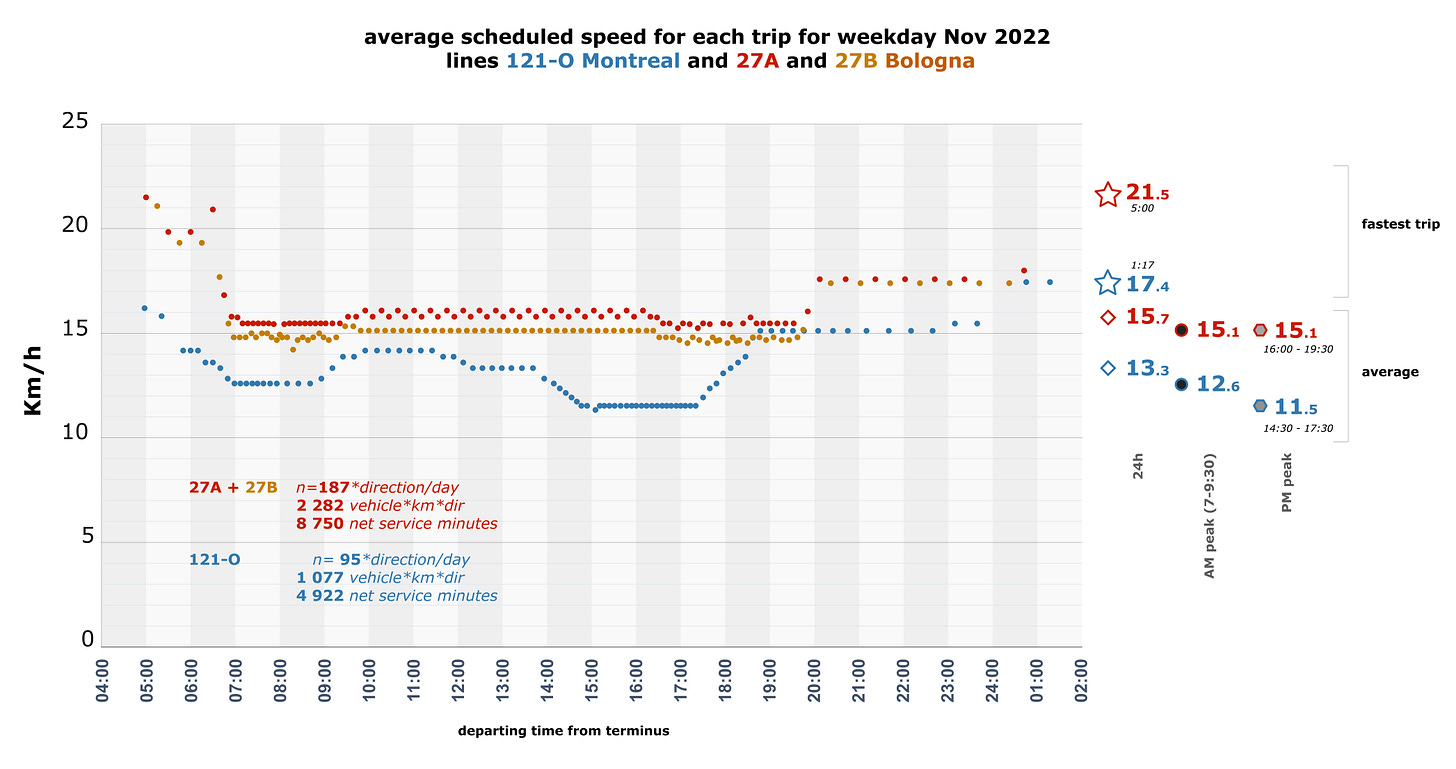
What’s the reason for such different performances? What makes mixed traffic transit in Montréal generally slower and much more sensible to rush hour delays compared to Bologna? The answer to that question is not as straightforward as it might appear, as several factors impact the performances of mixed-traffic transit. But a quick look at the data suggests that, to some extent, Bologna, Zurich, Vienna and all the other cities with faster mixed-traffic transit are doing something “better” in terms of operations and transit priority compared to cities where buses and trams are slow.
Every Second Matter
Mixed-traffic transit can be slowed down by long waits at traffic lights or controlled intersections in general. By congestion along their routes. By people queuing to enter through the front door and validating/paying their fare to or in front of the driver. By stops that are too closely spaced. By exiting and merging again into the main vehicular flow after stopping. Sometimes one simple vehicle blocked in the middle of an intersection can cause many minutes of delay in a single run, with delays cascading down the whole route because of the well known bus bunching phenomenon. Something as trivial as a person searching for their pocket change to pay the fare in front of the driver can make them miss a whole traffic light cycle, losing dozens of seconds. They are all trivial facts, you may say, but second add to second, making the trip longer and running times more inconsistent, pushing agencies to overpad their schedules, as the STM currently does for most of its bus routes adding 2-3 minutes between the second-last and the last stop of each trip.
Saving precious seconds in any of these operations is fundamental. Every second matter. Time, like costs, is a matter of multiple factors adding on top of each other and reinforcing each other. Delays on top of delays on top of other delays is how we end up with buses that are scheduled to run at a painfully slow pace of 10-11 km/h.
How can we solve this? How can we make mixed traffic transit faster? What can we learn from cities that seem to get it right? That’s what I tried to to with this post. For the ease of reading, I summarized the different speeding-up strategies we find in “virtuous” cities in two main topics:
How mixed-traffic transit is operated, notably how boarding and alighting are managed.
How transit priority measures are designed and implemented, that is how reserved lanes and traffic priority are implemented at the micro and macro level.
For the first topic, I will mainly focus on little and big details that make boarding faster, in particularly by talking about less debated topics. For the latter, I will first dive into the the micro-level, seeing how how bus priority is implemented in terms of street design and intersection management in our two main study cases of Bologna and Montréal, and secondly I will zoom out to the macro level, exploring the Zürich-inspired Bologna’s 1980s traffic plan and its implementation, which provide some interesting insight about the need of a comprehensive city-wide approach to transit priority.
Make boarding faster and smooth.
One of the main sources of delays for transit in general and for traditional bus transit in particular is boarding/alighting. The relationship between stop density and average speed is well known, and widely researched and discussed both among professional (see, for example: here , and here) and academic circles. The impact of stop density is also quite evident in our very small sample of six cities.
Stop consolidation is especially relevant to North America where bus stops tend to be much closer, in the 200-300 meters range. Efforts toward less densely spaced stops have been pledged by activists and agencies in many places across North America, as operation planners are well aware of their benefits for both commercial speed and operating costs. However, these schemes are often hard to implement because of political resistance and opposition from some riders’ categories, all within a decision-making process characterized by inertia and burdened by multiple veto points.
Other aspects linked to boarding procedures and bus layouts are known too, but are less discussed, at least for buses; that’s why I’ll focus on those. Elements such as more doors per vehicle, fare payment and internal layout play a key role in saving up a few seconds from dwelling times that often account for more than a third of the travelling time.
The more (doors) the merrier. Urban mixed-traffic transit stops frequently, and ease of boarding and alighting is key to reduce dwelling times. The typical North American bus has two doors for 12m buses and three for 18 m articulated ones (sometimes only two). And sometimes even less. As a comparison, the typical Italian urban bus has one more door: three for the 12m ones, and four for the articulated bus. Moreover, boarding is allowed from the front and back door only, while alighting passengers use the central door(s), avoiding conflicts between the two flows. As a comparison, in Montréal alighting is allowed also via the front door, potentially further delaying boarding passengers.
Internal bus layout and fare payment. “Move to the back!” How many times did you hear that phrase yelled by your bus driver during rush hour? Internal ease of movement is fundamental to not slow down boarding. Moving ticket validation and onboard ticket purchasing machines inward, far from the entrances, helps avoid the bottleneck of boarding passengers that often make our buses loose more precious seconds at particularly crowded stops, a phenomena more severe at rush-hour and in case of bus bunching. In the Bolognese example, the ticket validating machine and the ticket-purchasing ones are a few meters inside the bus at both ends, not right at the doors as they are in Montréal. Coupled with all-door (more precisely, back and front door) boarding, it’s a low-investment change that can be implemented by the agency almost overnight without complex coordination. Yet, it’s a big cultural shift, as it requires the agency to move to a Proof-of-Payment honor-based type of fare verification.
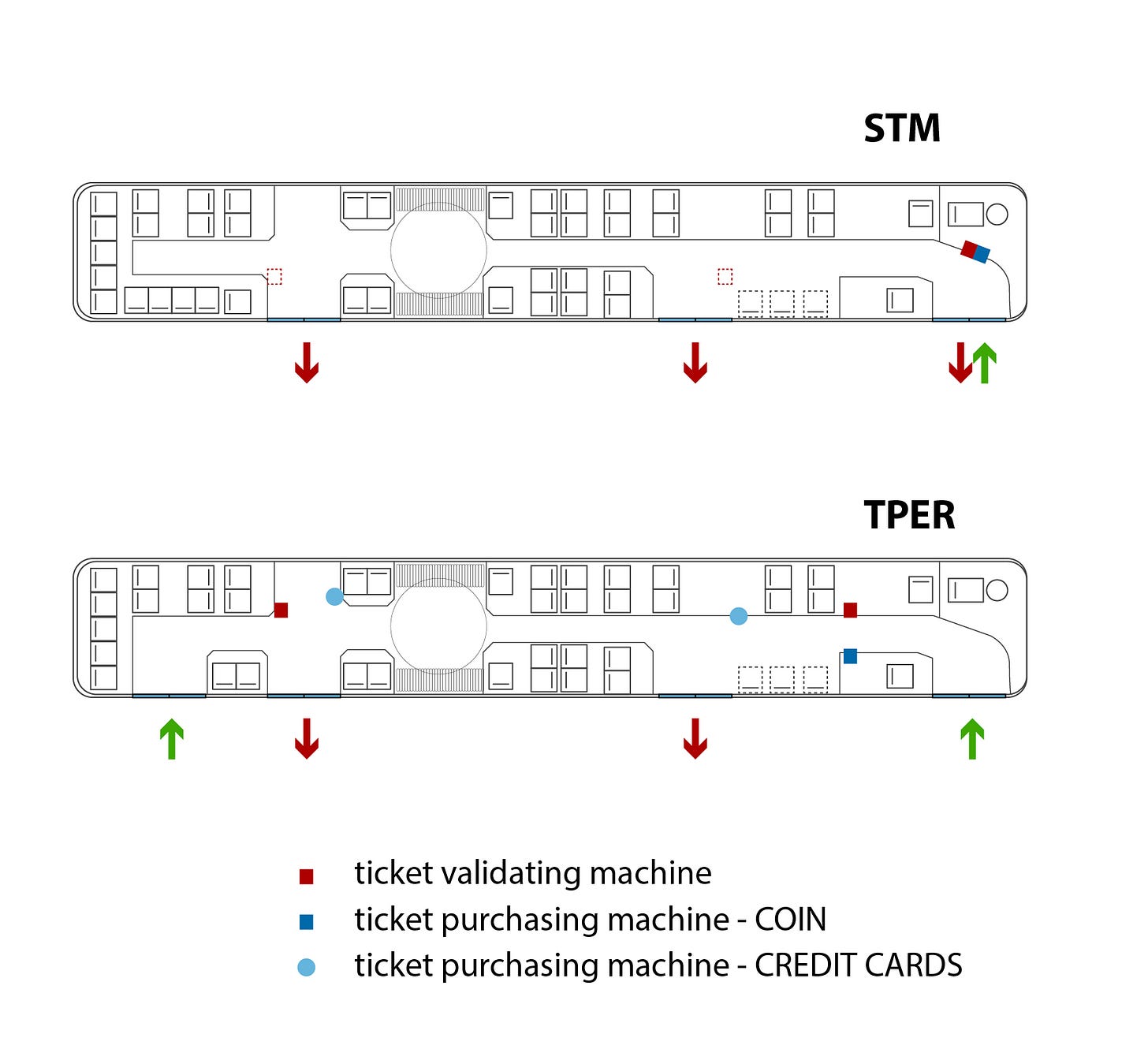
Bus bulbs and Step-less boarding. I will brush through these points quickly because they are well known and discussed, but both are effective measures to reduce dwelling times that should be rolled out on all the conventional bus network as part of a rolling program of routine improvements, not only on BRT-like routes. Bus bulbs, in particular, should be the default design for stops whenever buses and streetcars run in mixed-traffic along a curb-side parking lane. Again, this is something that Bologna, Vienna and Zurich have been doing extensively, while Montréal, Milan and Toronto have lagged behind. Bologna, has deployed them in great numbers over the years on all the urban routes, not just the main ones, mostly leveraging the funds from traffic fines (which, since 1992, can be used by cities to support traffic safety infrastructure) to fund a rolling program that has been going on for two decades. Step-less or quasi-level boarding is trickier (and costlier) but feasible. It can be achieved by using design elements like the Kassel Kerb for platform edges. Full, ADA-compliant level boarding can be achieved on buses too, thanks to a more sophisticated technological approach, such as the one used in the new Crealis trolleybus in Bologna, that uses a camera-guided approach to platform
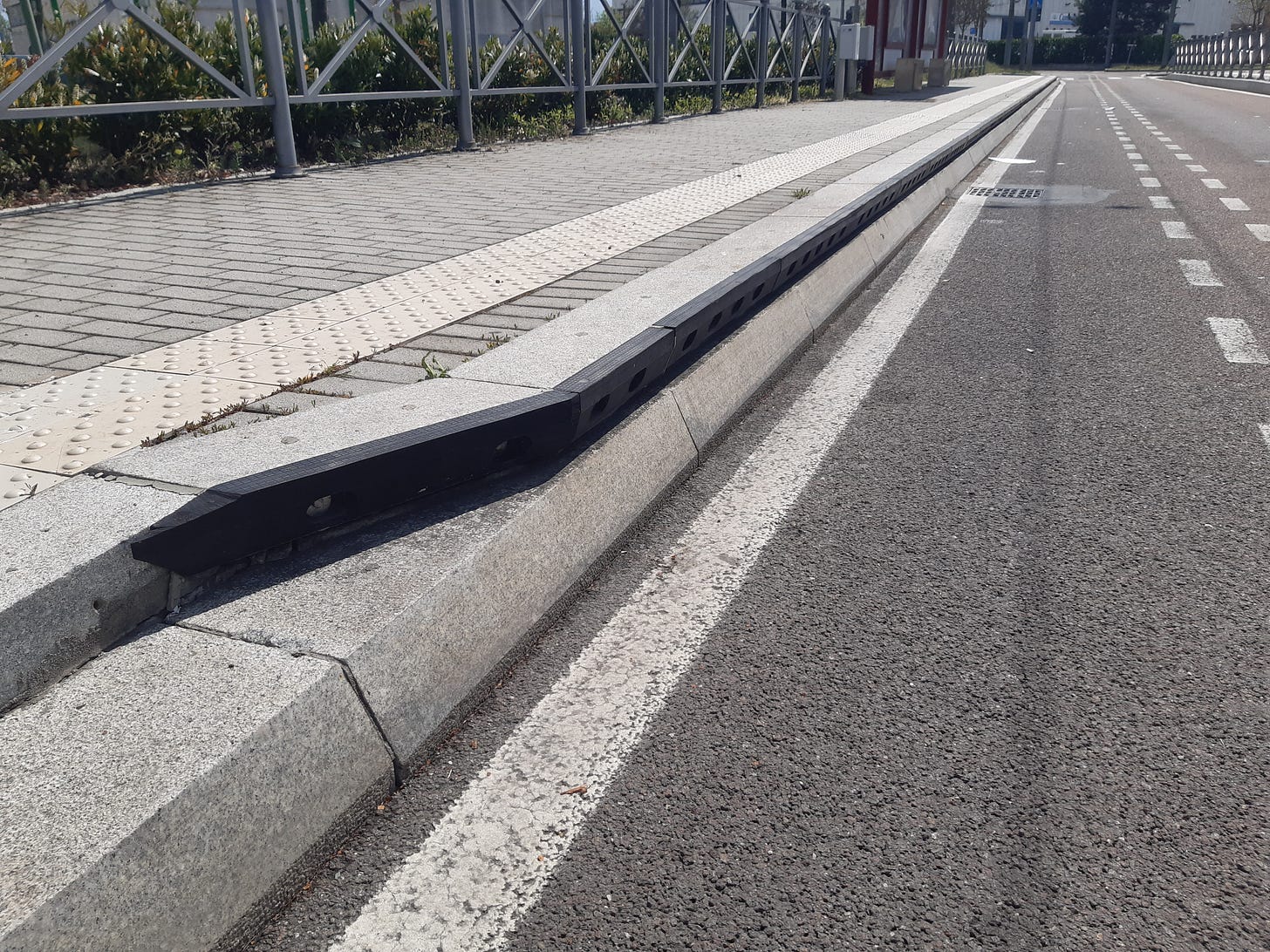
Goes without saying, it is much easier to provide level boarding when mixed-traffic transit runs on steel tracks, like in Toronto. However, unlike Zurich and Vienna, way too many streetcar routes in Ontario’s capital are still treated as buses-on-steel-wheels, not worth more than a faded signage on a pole as stop infrastructure, leaving people alighting and boarding through traffic lanes at their own risk.
Effective transit priority: not just a matter of reserved bus lanes
One may argue that Montréal, Toronto and Milan just needs more reserved lanes and traffic light priority to make buses faster. Let’s roll out the red carpet for those buses and streetcars! However, during rush hour, many of the busiest bus lines in Montréal already mostly run along reserved bus lanes. Three of them, 165, 67 and 105, have around 4/5th or more of their route “on a red carpet”. The 121 recently got the red carpet treatment as red concrete bus lanes have been rolled out on a section of Sauvé, and the STM pompously called that an SRB (BRT in French). Yet, these buses on a red carpet are not the fastest, by far. The graph below shows that, at least for Bologna and Montréal, there seems to be no correlation between the percentage of the route in reserved lanes and the average speed at rush hour.
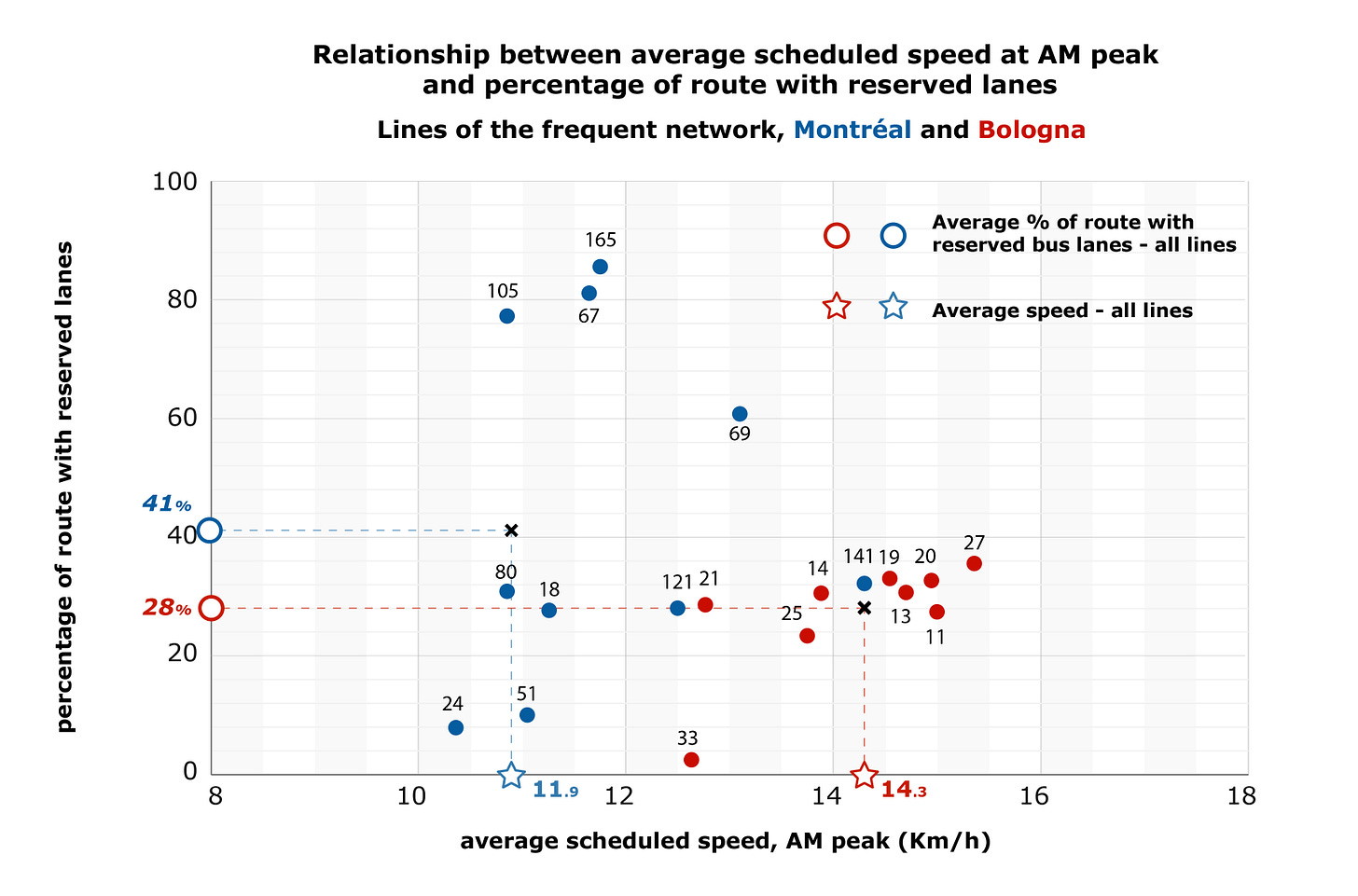
Why do bus lanes in Montréal seems less effective in ensuring faster trips? Part of the answer can come from a comparative micro analysis of how the bus lanes are designed and how conflicts with other traffic flows are managed, notably at intersections. For that, I compared two 1.6 km sections of route 14 in Bologna and route 165 S in Montréal, both running 100% in reserved lanes (at least at rush hours, for Montréal). As is often the case, Devil appears to be in the details, in the “how”, more than in the “how much”.
Trolleybus line 14, which runs on a contraflow bus lane along via Sant’Isaia and via Andrea Costa, is scheduled to take 8 minutes at peak (7’ off-peak) to cover the 1.7 km, 6-stop ride between Piazza Malpighi and Martini. Along its route, it crosses 32 intersections (accounting for each side separately, as the street layout is not gridded), but only 6 are controlled by traffic lights, which are remotely managed to provide dynamic bus priority. Generally, the traffic from the side streets is regulated through yields or stops, while the main street has priority. Several intersections have continuous sidewalks across the lateral streets. Moreover, most side streets are one-way, and when two of them are facing each other, they are in opposite directions as to prevent crossing traffic, greatly reducing the number of possible maneuvers to, from and across the bus lane and the main main street, which is itself one-way for general traffic. Finally, along its route on the contraflow bus lane, bus 14 never share its lane with same-direction right-turning traffic. By experience, that arrangement generally makes for a pretty smooth ride. Not negligible detail, the bus lane is camera controlled 24/7.

Bus line 165 takes 12 minutes at peak for a slightly shorter 1.5km, 8-stop journey between Côte-des-Neiges / De Bedford and Station Côte-des-Neiges. Bus 165 runs on a “rush-reg” bus lane, in other words, a curb-side lane that is reserved for buses during rush hour only, normally 6-9 weekday AM in Montréal for the morning peak direction, and is used for parking during the rest of time. But even during rush hours, same-direction vehicular traffic can use the lane for right-turns at intersections, and that happens at nine locations in the analyzed section. Moreover, southbound bus 165 crosses 25 side streets (accounting for each side separately) and 19 of them are regulated with traffic lights, none of them being remotely controlled for effective transit priority yet. Compared to bus 14, the trip of bus 165 looks more like a hurdling competition rather than a smooth ride on a red carpet as the reserved lanes are supposed to provide. Even though both our study cases are, on paper, 100% along reserved bus lanes, the actual design make them completely different.

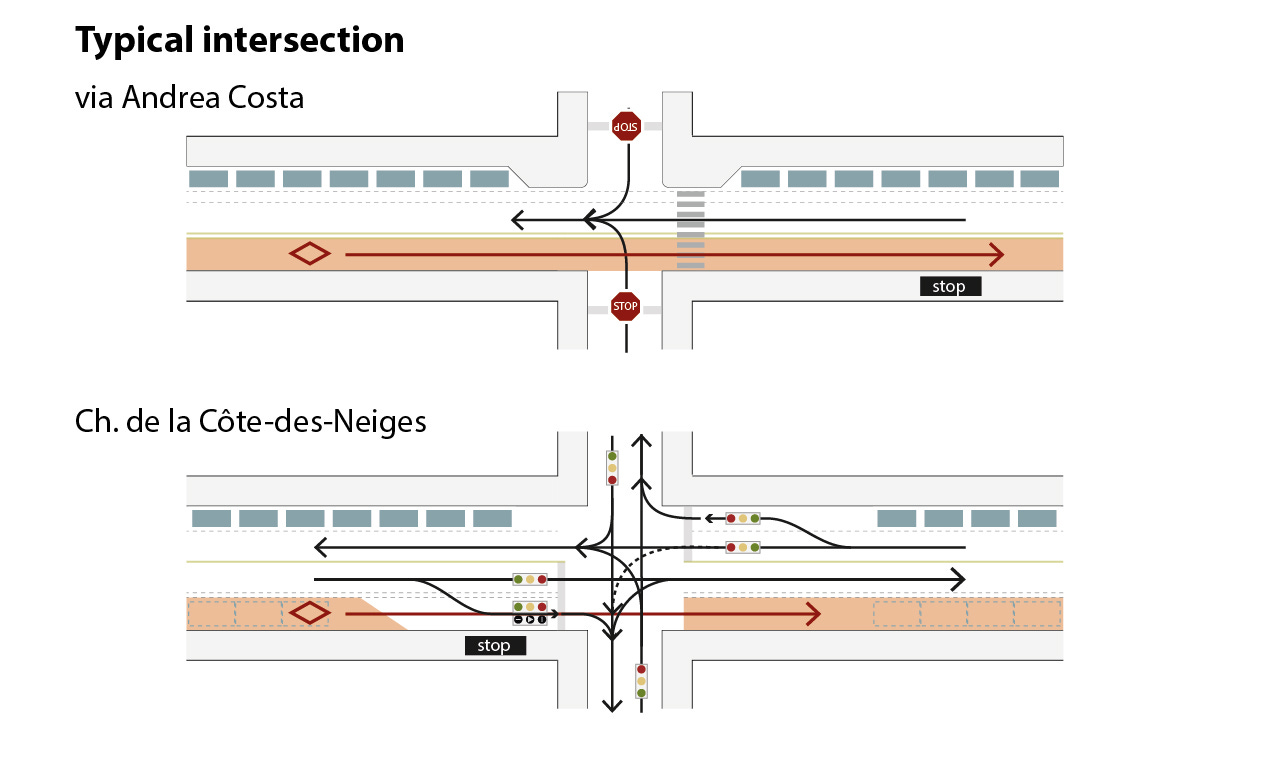
This micro comparative analysis brings us to another major issue that, unlike stop density, is seldom discussed: controlled intersections density is wildly different between our two study cases and, as for stops, it’s way higher in Montréal. On average, Montréal’s main bus lines cross one controlled intersection (regulated by traffic lights or a 4-way stop) every 191 meters, even more frequently than they stop for picking up and dropping off passengers. On the other hand, Bologna’s main bus routes encounter a controlled intersection (all of them being traffic lights), every 346 meters, slightly less often than for stops. For people who have experience going around on both sides of the Pond this should not be surprising: traffic lights are much more common in North America, especially in denser gridded parts of cities, than they are in Europe. Bologna has some 230 intersections with traffic lights on 850 km of city-owned streets, that is one every 3.6 km. Montréal has 2,300 intersections managed with traffic lights for 4,100 km of city-owned streets, meaning one every 1.8 km, with the density being particularly high in east-west streets in the pre-war gridded inner neighborhoods. Because of the combined effect of high density of both stops and controlled intersections, Montréal’s buses are hurdling along most of the time.
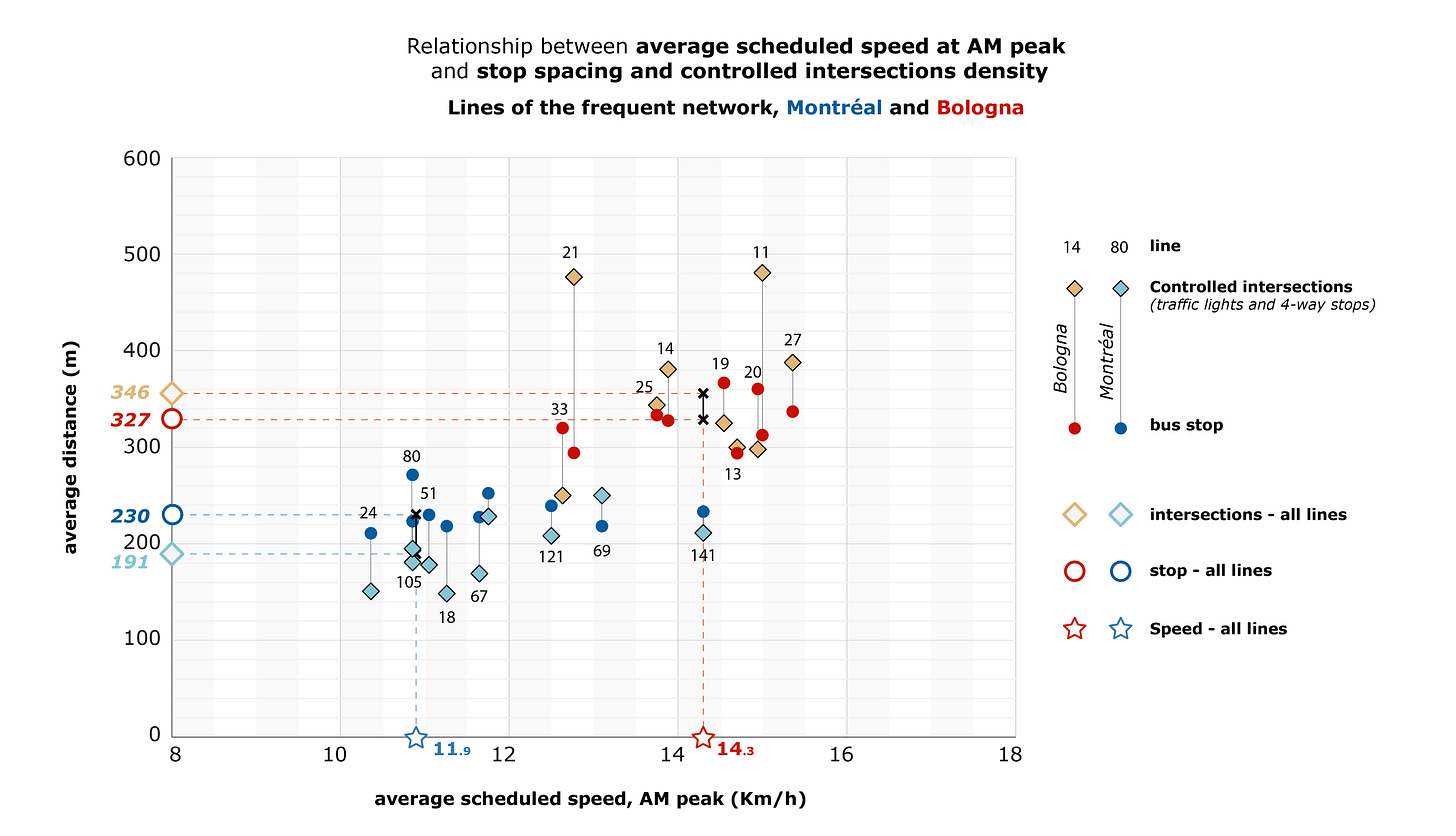
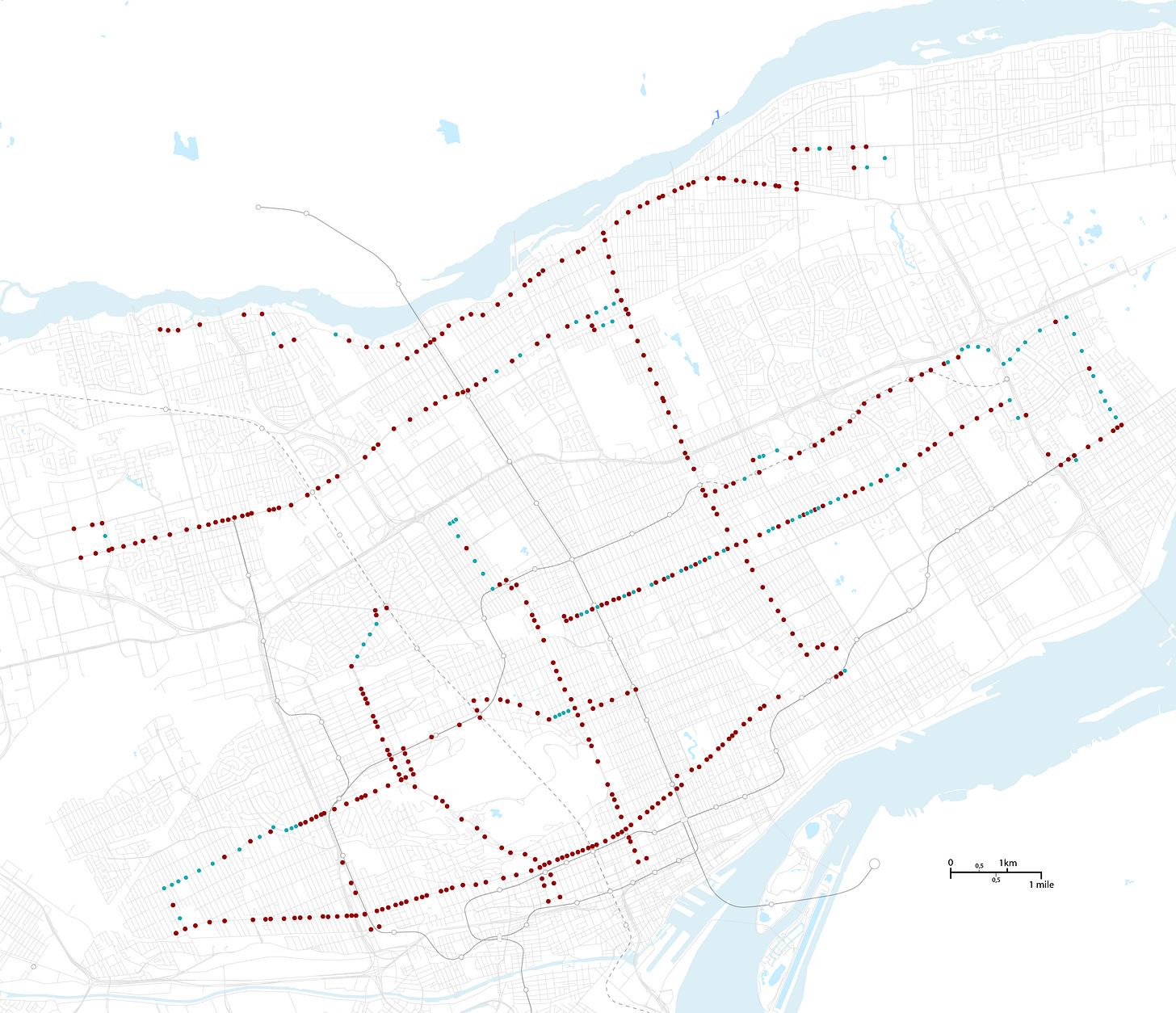
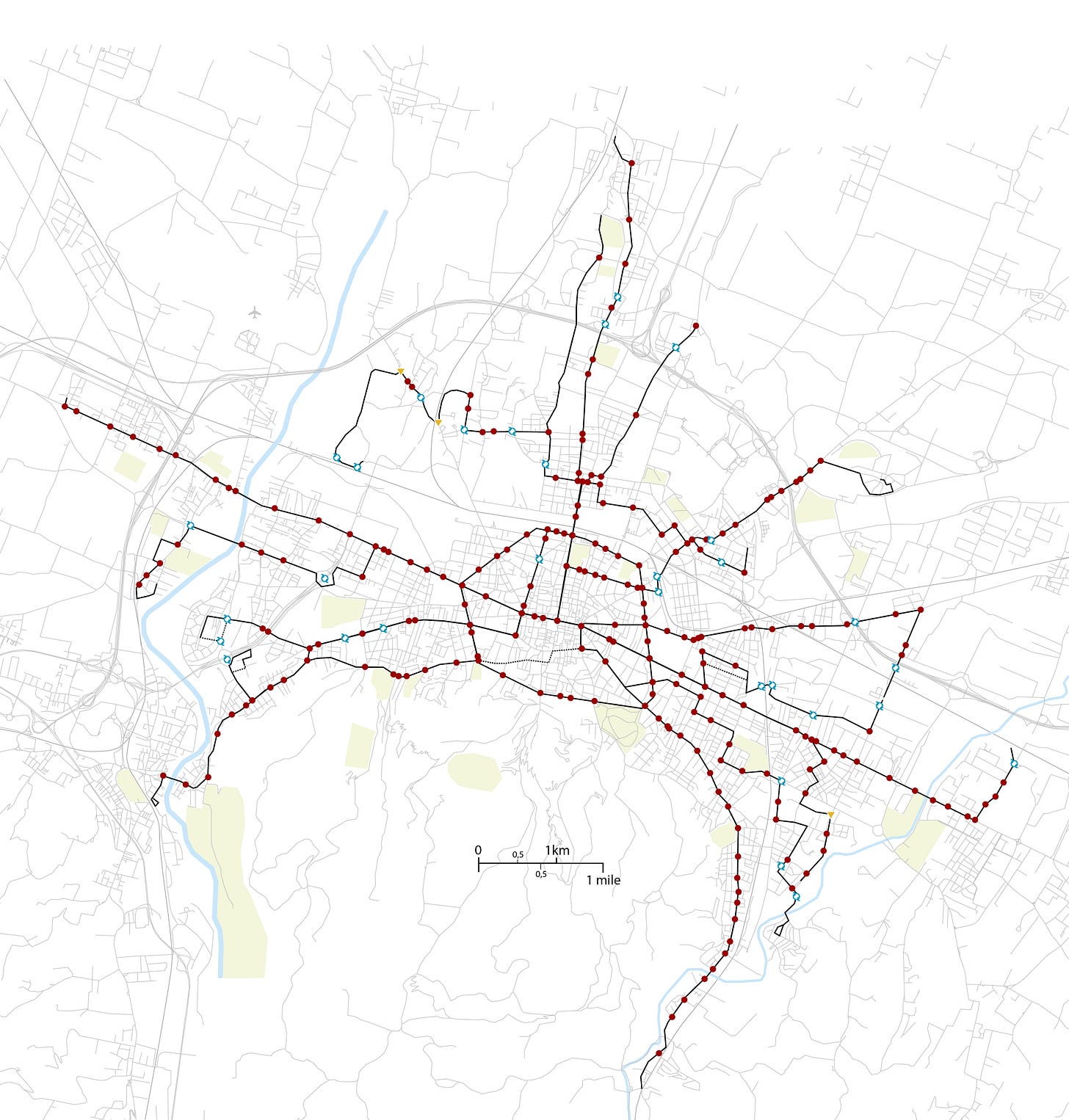
Lessons from Bologna’s 1980-90s “traffic revolution”.
How can bus priority measures be deployed more effectively? Are there real-life examples of cities that rolled out relatively capital-light and fast-to-implement comprehensive transit priority measures that can speed up our conventional buses without spending $50 million per km for full-scale BRT, an investment we could never afford everywhere? The answer is “yes, there are”. There are actually many good examples around. In this post I will dive deep into Bologna’s “traffic revolution”. In the late 1980s, Bologna didn’t only redesign its bus transit network, but it did so in conjunction with a deep reorganization of how private vehicular traffic goes about the city. In the space of a few months, roads were closed, traffic patterns were changed, vehicular flows diverted as intersections were rearranged and dozens of kms of contraflow bus lanes were rolled out throughout the city. This is quite different from the hyper-localized or corridor-based siloed implementation typical in North America, and that is why I think it’s worth looking into Bologna’s example. Moreover, Bologna’s experience, as many Italian examples, runs under the radars, while Zurich’s transit priority strategies are more internationally known and well documented in English. In a way, Bologna’s now more than thirty years-old traffic plan is also interesting because it’s a successful case of “learning from others”: the city-wide traffic arrangement that I will describe in the following section was put up between the late 1980s and the early 1990s with help from a Zurich-based consultancy firm led by Willi Hüsler (also involved in the tram + S-Bahn 1993-95 plan) and professor Bernhard Winkler from Munich’s Technische Universität.
The Great Walls of Constantinople (but for cars)
The stereotypical image of old pre-gunpowder defensive systems is that of a big, tall wall with towers encircling a city. In reality, most defensive systems have always been based more on the depth than on the height, using a layered succession of different defensive works. The Theodosian walls of Constantinople, possibly the most outstanding example of defensive engineering of the Late Antiquity, were a deep succession of elements: the moat coupled with a first low wall, the outer wall and the inner wall. The purpose of this layered approach is not to block the assaulting enemies outright with a single direct obstacle, but to first slow them down, weakening their impetus and then making it easier to deal with the fewer ones among them who finally make to the real wall.

What does this have to do with bus priority in Bologna? Because the 1980s traffic plan works, somehow, on the same principles as the walls of Constantinople. Three concentric layers of increasingly hostile traffic arrangements have been put in place to slow down, divert or outrightly block private vehicular traffic from reaching the inner part of the city in high volumes and from using the most direct thoroughfares for through trips across the city. Instead of a moat, an outer wall and an inner wall, Bologna has: i) a “contraflow bus lanes belt”, ii) a limited traffic area (ZTL), and iii) an ultra-limited traffic area (Area T) in the very core, as its “layered defensive system” against the assault of private vehicles.
1. “The contraflow belt”, is Bologna’s moat.
In an area that roughly corresponds to the 1889 expansion plan, a ~2 km belt around the ring boulevards (Viali di Circonvallazione), traffic has been rearranged to reserve the most direct routes to buses while private vehicular flows have been diverted. The main tool for achieving this “traffic diversion strategy” is the extensive rollout of contraflow bus lanes on major radial arterials. Out of the twelve main thoroughfares converging to the ring boulevard, eight carry one or more trunk frequent bus routes. On these eight arterials, contraflow reserved bus lanes have been established since 1988-89, mostly in the inbound direction, while private vehicular traffic has been diverted along circuitous indirect routes. The advantage of long contraflow bus lanes, that is uninterrupted bus lanes running in the opposite direction of the rest of vehicular traffic, is that buses run on the curbside space unimpeded by right turning and parking vehicles or other near-curb conflicts that normally reduce the effectiveness of curb-side dedicated transit lanes in many North American contexts, as we have seen in the aforementioned example of via Andrea Costa versus Chemin de la Côte-des-Neiges. Non-negligible detail: Bus lanes in Bologna are active 24/7 and compliance is enforced by cameras and automated ticketing, through a system called RITA (Rete Integrata di Telecontrollo degli Accessi).
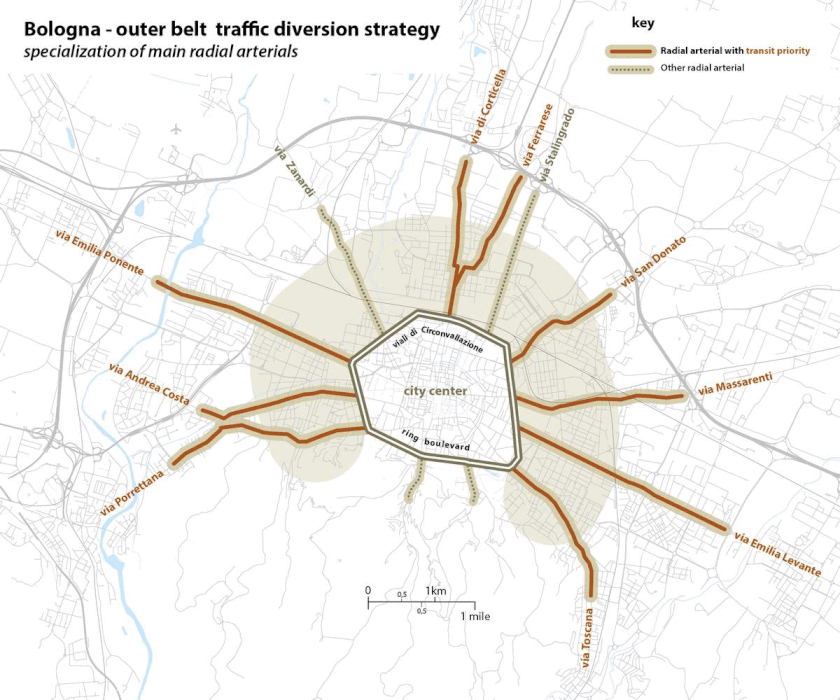
Zooming into one of these traffic diversion arrangements in the Bolognina neighborhood (see picture below), we can better understand how bus lanes, road closures and one-way streets have been strategically deployed to divert and disperse incoming and outgoing vehicular traffic away from the main thoroughfare in the area, via Matteotti, where five trunk bus lines converge before heading into the city center, in addition to several local and suburban lines (see second picture).
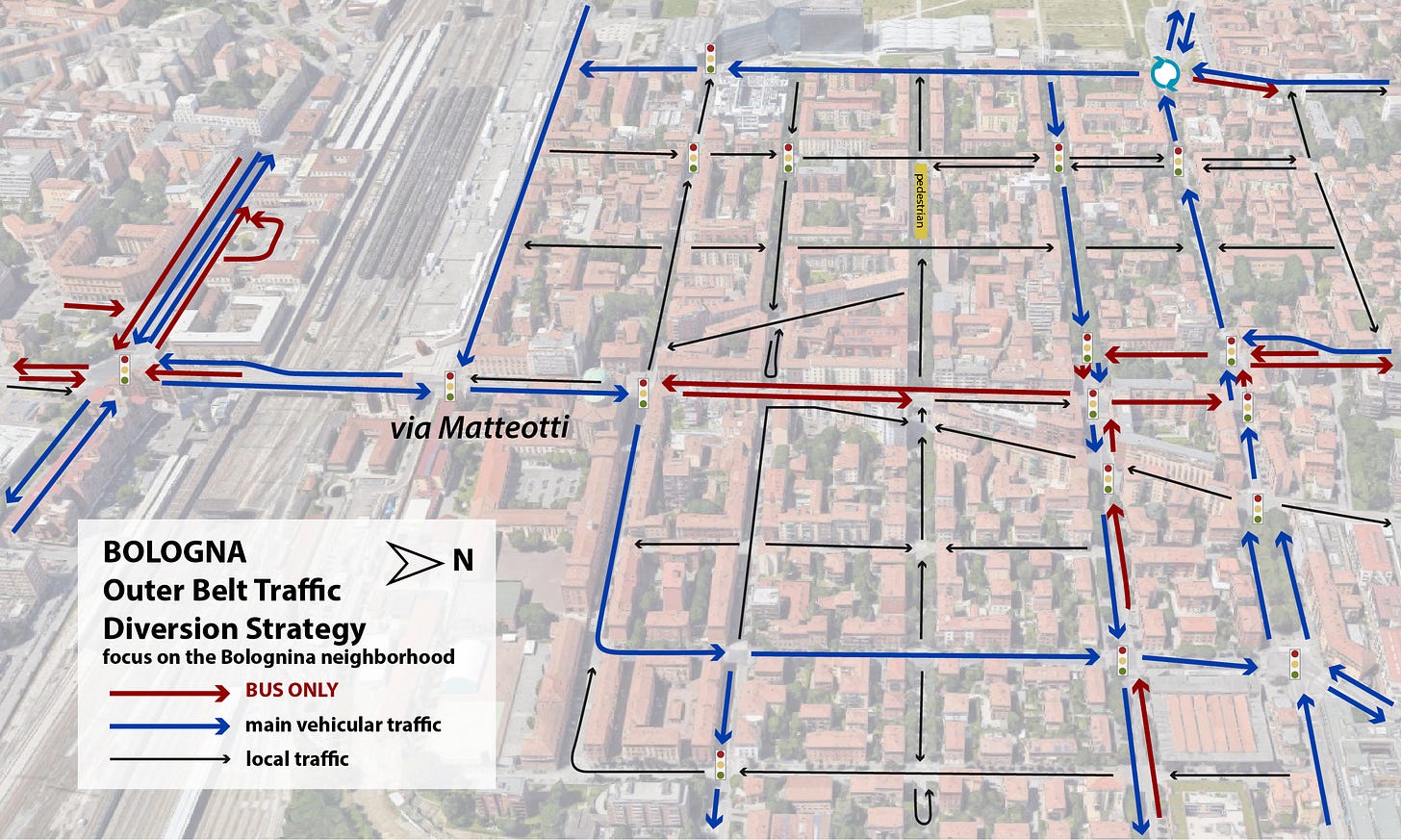
Focusing on Via Matteotti, we can understand how the strategic deployment of bus reserved lanes is used to “break, divert and delay” private vehicular flows. Heading North after the bridge over the rail station, the first block is two-way for vehicular traffic, but only the north-bound lane sees significant flows as the south-bound one mainly serves local traffic and buses, because of the arrangement upstream and in the surrounding streets. For the following two blocks via Matteotti is bus-only in both directions, and crossing traffic from the lateral streets have been blocked with a simple row of bollards and prefabricated curbs; On the subsequent and final block, via Matteotti is again bus-only south-bound, but open to general traffic north-bound. However, thanks to “looping” traffic flow arrangements in the surrounding streets that make through traffic inconvenient and because of the previous two-way bus-only section, this last stretch receives only very scarce local traffic. So, despite it being embedded on a gridded setting with multiple crossings, conflicts with other traffic flows are minimized by making via Matteotti a main arterial for buses but, at most, a very local lightly used street for all the other vehicles.
2. The ZTL “Limited Traffic Area”. The outer wall.
The second layer of “defense” is the Limited Traffic Area (ZTL – Zona a Traffico Limitato, in Italian), that is an area of some 3.2 square kilometers encompassing most of the old walled city inside the ring boulevard. Within this camera-controlled area (SIRIO is the name of the automatic enforcement system), private vehicular access is restricted between 7 AM and 8 PM. Residents, owners or renters of off-street parking spaces, people with disabilities, emergency vehicles, and others can enter by right. In 2017, there were some 29,000 vehicles allowed to enter the limited traffic area, out of some 200,000 cars registered in the city and almost 600,000 in the whole Metropolitan City. Deliveries can get special permits valid for a given time and linked to an unloading spot. Moreover, occasional daily permits for private cars can be purchased for €6 for a maximum of 3 non-consecutive days or for a single 4 consecutive day period in a month. Thanks to this rather complex system of rules, the number of vehicles entering the ZTL has declined from 67,400 per day in 2004 (last year without a camera-enforced system) to 38,100 in 2017. The number of vehicles permitted to enter by-right will further shrink in the future as a stricter ZTL-A rule is being progressively introduced, notably shelving residential permits for the second and third car in a household.
To further reduce the impact of vehicular traffic on transit within the narrow streets of the city’s core, contraflow bus lanes and other arrangements have been adopted over time also within the ZTL itself. The most important one is the inner-most layer of our Great Wall of Constantinople.
3. “Zona T”. The “Tee Zone”, a reversed T-shaped area comprising the two major 19th-century axes of the old city at the very core of the city center is the Donjon, the inner-most fortified tower. Within these two streets, that accommodate more than 130 buses and some 10-12,000 bus riders between 8 - 9 AM, only transit vehicles, bikes, and motorbikes are allowed on weekdays, while the are is pedestrianized during the weekends. Limited access can be granted to particular categories upon request. Within the Limited Traffic Area, the T operates as the central piece of a number of traffic management arrangements that are based on the same principles used on the outer belt: give transit the most direct route via the main thoroughfares (via Rizzoli, vis Ugo Bassi e via dell’Indipendenza) while pushing through traffic to circuitous routes avoiding the city’s inner core and making it faster to just drive back to the ring boulevards and use them for through trips.

Traffic light priority: a city-wide approach.
On top of this three-layer strategy, since the late 1990s Bologna has implemented a centralized traffic light management system covering 75% of the controlled intersections in the city. The system, emphatically called UTOPIA, was modelled after the perimeter control scheme rolled out in Zurich. Thanks to more than 1,000 traffic detectors and real-time GPS data of the bus fleet shared by the transit agency, UTOPIA gets real time information of traffic volumes and can modulate the length of traffic light phases using a predictive dynamic traffic model in order to delay private traffic upstream of congested areas until they are cleared, while also giving priority to transit, especially when buses are running late. This system has received the "Bangemann Challenge Award" in 1999 and is estimated to have reduced travelling times by 12-15%.
What’s the lesson?
Bologna provides an interesting case study of a city that stretched what traditional bus system can do without building BRT or LRT, deploying many of the available “low-cost” strategies to improve average speed, reliability and regularity across its entire mixed-traffic “traditional” bus network, in particular on the 10 frequent trunk lines that account for 80% of the city’s urban transit ridership and the bulk of the operating costs. By implementing a mix of changes in boarding practices, by building targeted small but diffused infrastructural improvements in a systematic way, such as the rolling program for bus bulbs, and by rolling out priority measures in a targeted and coordinated way at the city level, within a general comprehensive vision of transit priority in the city’s core, Bologna boasts today quite a performing transit system entirely based on “normal” buses. Nevertheless, it moves 320,000 passengers daily, and ridership has been growing from 97 million passengers per year in 2013 to 117 million in 2019, despite a substantially stable level of service of 17.9 million vehicle*km, bringing to a higher farebox recovery ratio of around 50% before covid hit. And this despite the egregious failure of building much needed rapid transit on the busiest corridors since the early 2000s. As a side benefit of a well performing bus system, there are no talks of cutting service right now as ridership has recovered and operating costs are under control, unlike in Montréal.
This post was intended as a quick overview of some micro and macro-level real-life strategies used to make mixed-traffic transit faster and more reliable, mainly diving into what Bologna does differently from Montréal to get its mixed-traffic transit move faster. I hope that this partial exploration into how buses are operated and how small and big traffic priority measures are implemented in these two cities, helped to give the readers a broader perspective into this extremely complex issue. The aim is not to give a definitive answer about the “best” way to ensure traffic priority, nor to argue for the “superiority” of one approach versus the other. The purpose of this post is mainly to show that “traditional” mixed-traffic transit systems are not, by definition, a second-tier, hopeless, and residual type of transit. There is definitely life and room for sensible improvements in the policy space that lies between a bus system relying on barebone infrastructure with no priority whatsoever, and the full-scale fancy BRT infrastructure worth $50 million per km and needing 13 years of planning, design and construction.
In conclusion, what really stands out from Bologna’s 1980s traffic plan as a striking difference compared to most North American cases is the comprehensive approach the city has taken, thanks to political leadership, an institutional setting that puts the municipal government at the center of the decision-making process, and the existence of a dedicated planning tool to achieve that, the Comprehensive Urban Traffic Plan (PGTU – Piano Generale del Traffico Urbano).
Fundamentally, I think that the main takeaway for North America is that a bus redesign plan that doesn’t go hand in hand with a coordinated general redesign of vehicular traffic flows at the city level, at least in its core, will always be a half-baked solution. In my opinion, corridor-by-corridor approaches are bound to fail or, at least, underperform and to be extremely time-consuming for planning departments. A comprehensive traffic plan that takes into account the interaction of private traffic and transit is, I believe, the best way to approach transit priority in an effective way.
To conclude, I think that real-life examples such as Zurich and Bologna show that there is an enormous space for improving the quality and speed of our mixed-traffic transit service with minimal capital investment for a very high return on both ridership and lower operating costs. And this is very good news, as these are mostly low-hanging fruits in terms of capital costs. The bad news is that these interventions, that will profoundly affect how drivers experience the city, require a lot of political will, especially in the fragmented institutional framework and veto-burdened decision-making process typical of transit governance in North America. And God knows how scarce political courage is when drivers need to be inconvenienced, even if it’s for the greater common good.
This is not a peer-reviewed study, but rather a quick exploratory investigation, mainly based on the analysis of scheduled running times provided by transit agencies and other metrics manually measured using google maps and collected in a spreadsheet (that you can borrow and improve!) for a quick comparative analysis.

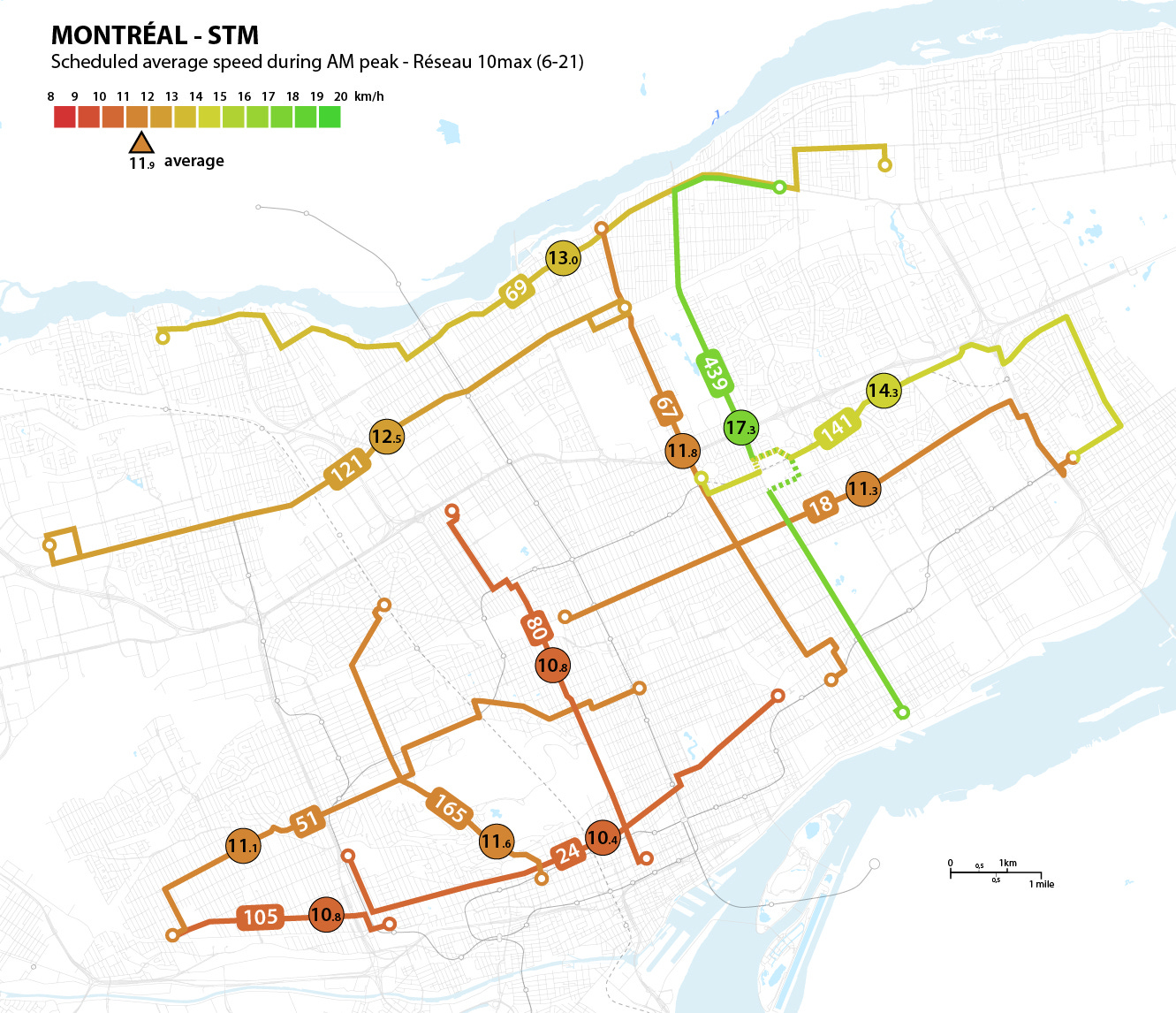
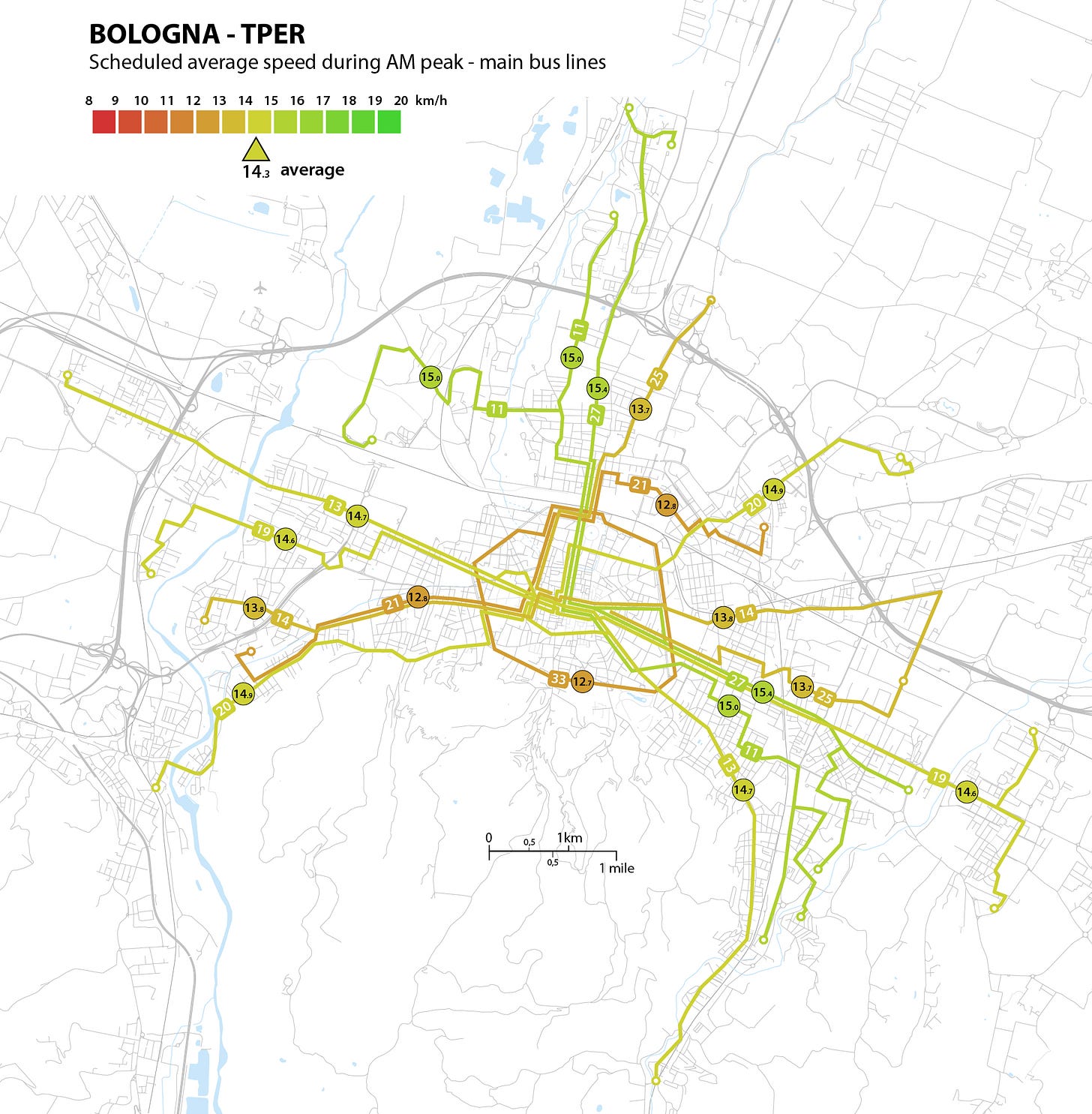


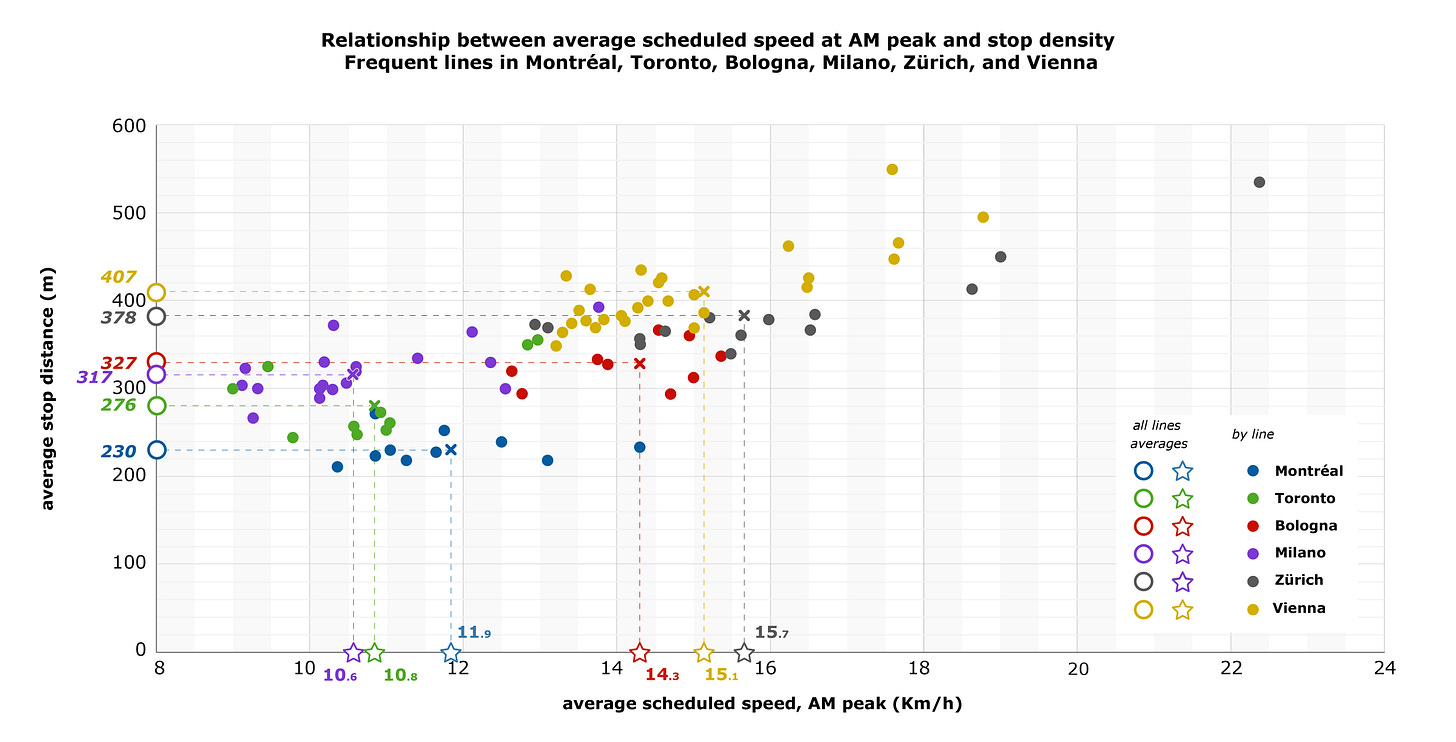
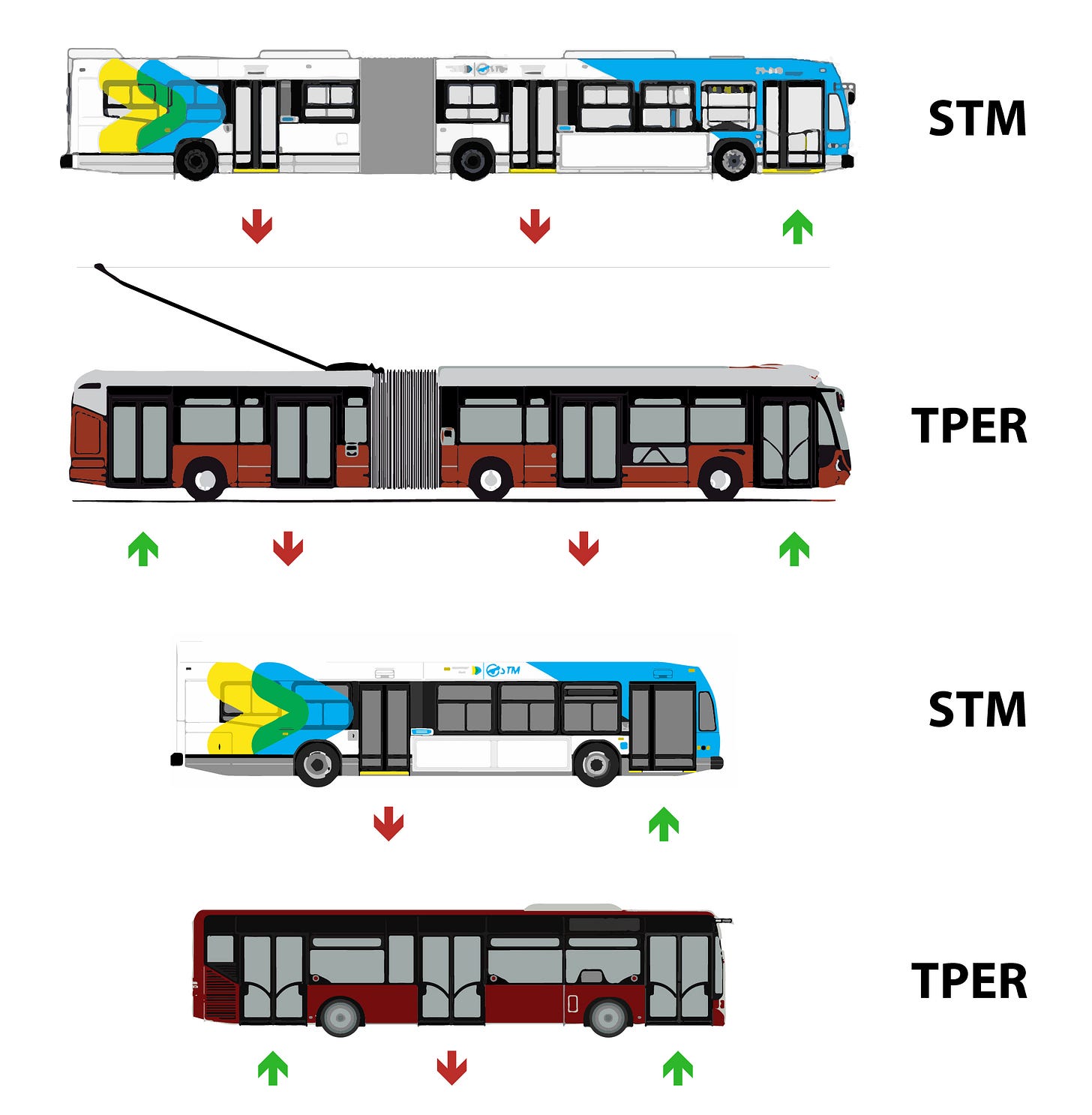
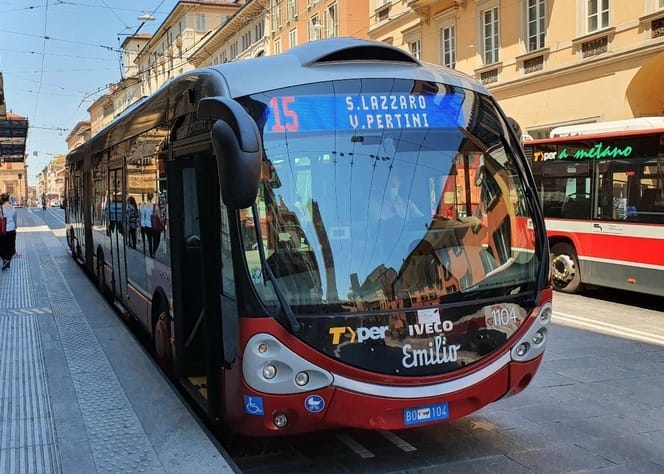
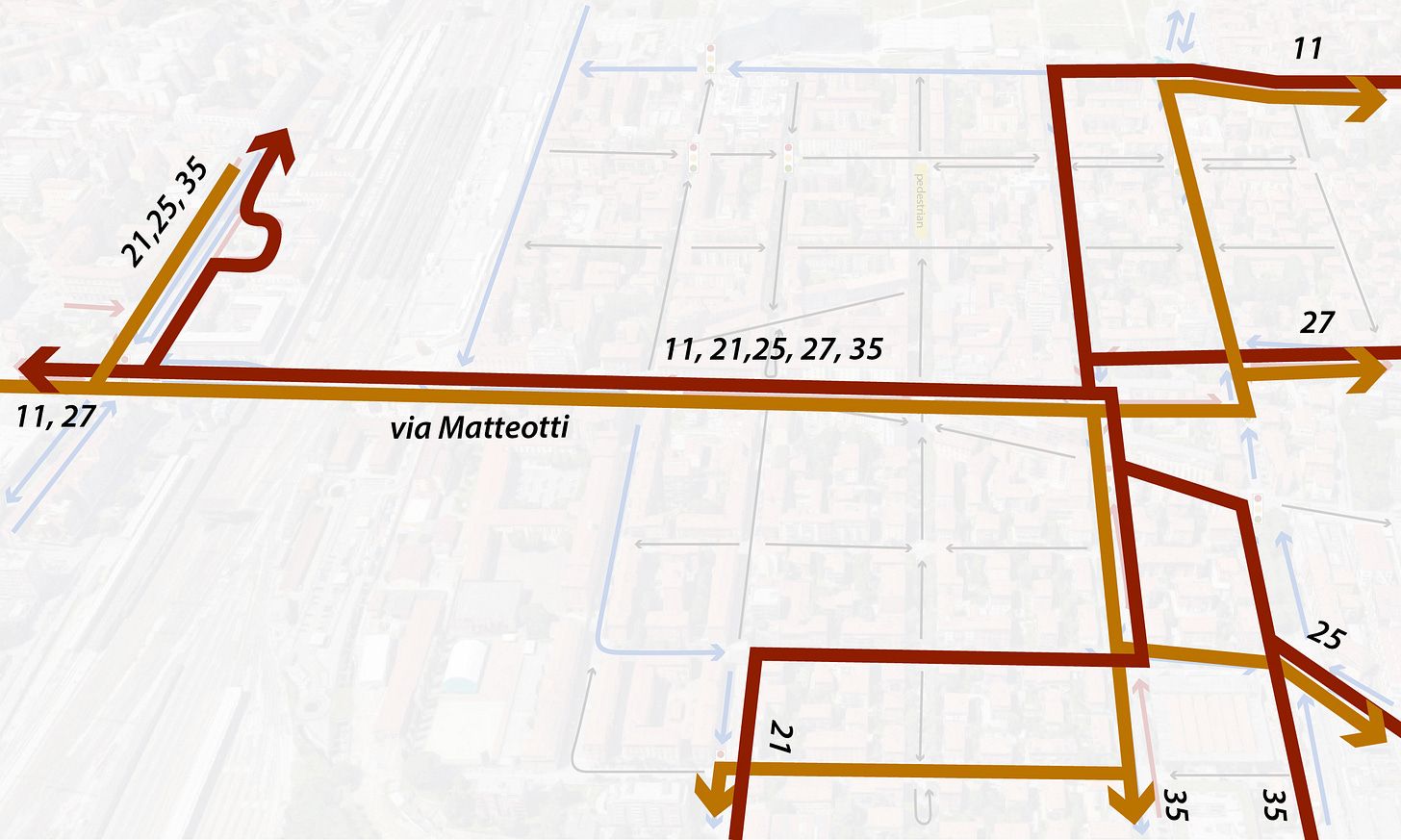
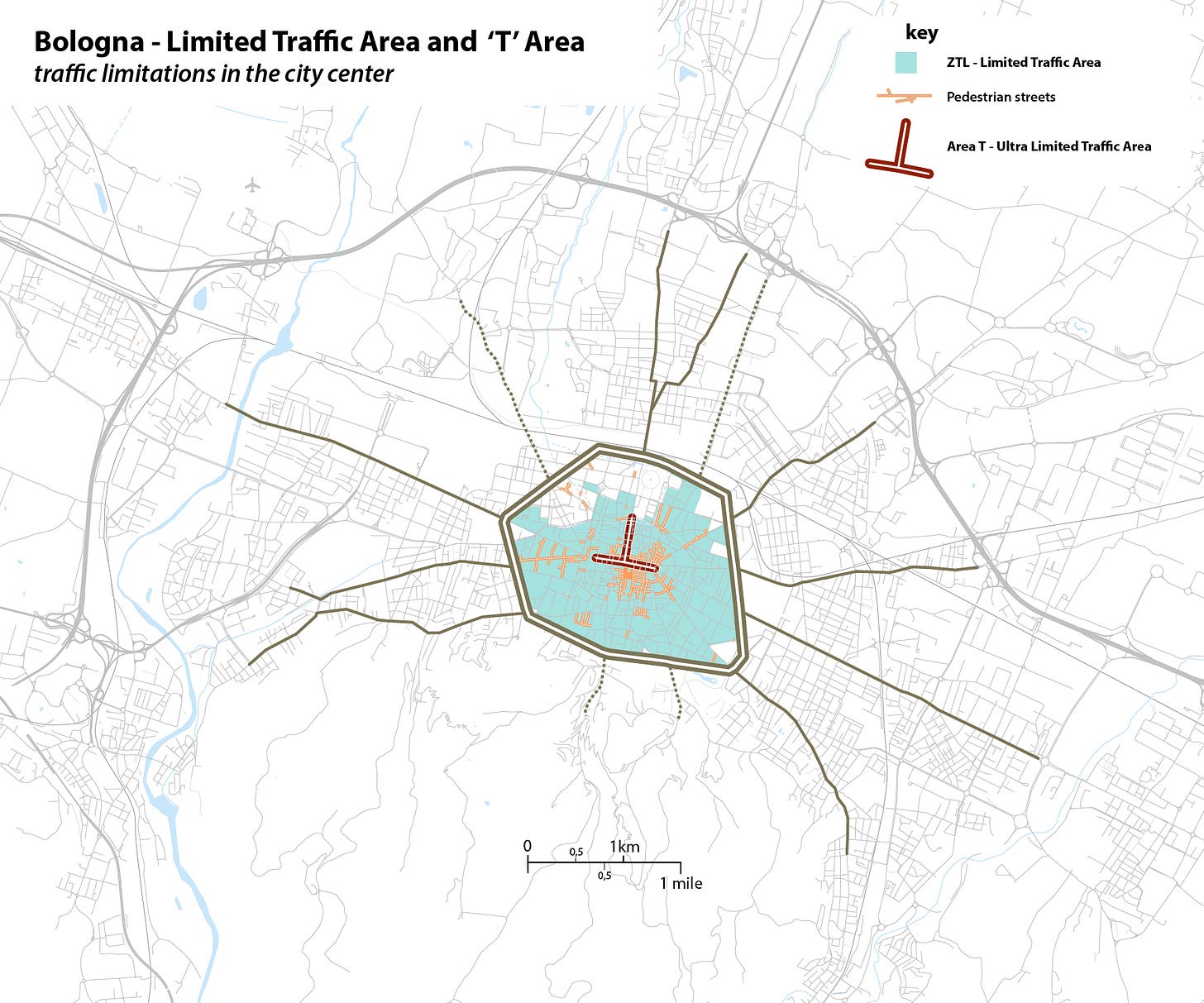
The quality of this post is nuts. Excellent stuff!
Truly an amazingly well written piece. Would be happy to support this financially to keep getting these awesome insights.